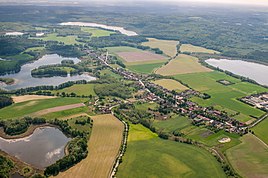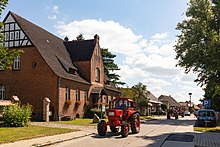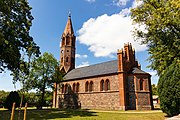Brodowin
|
Brodowin
Chorin parish
Coordinates: 52 ° 54 ′ 39 ″ N , 13 ° 58 ′ 0 ″ E
|
|
|---|---|
| Height : | 57 m above sea level NHN |
| Area : | 6.22 km² |
| Residents : | 409 (December 31, 2011) |
| Population density : | 66 inhabitants / km² |
| Incorporation : | December 31, 2001 |
| Postal code : | 16230 |
| Area code : | 033366 |
|
Brodowin from the air, from the north
|
|
Brodowin is a district of the municipality of Chorin in the Barnim district in Brandenburg . Until it was incorporated into Chorin on December 31, 2001, Brodowin was an independent municipality administered by the then Britz-Chorin office.
location
The town of Brodowin is located in the Schorfheide-Chorin biosphere reserve , about 14 kilometers as the crow flies northeast of the town of Eberswalde and borders the Parsteiner See with its north-eastern boundary . Surrounding villages are of the city Angermünde in Uckermark belonging district Bölkendorf and the district Parstein the community Parsteinsee in the Northeast, Oderberg in the southeast, Liepe in the south, the west and Chorin Serwest in the northwest.
There are seven lakes in the Brodowin district, which is why Brodowin is also known as the village of seven lakes . In addition, the district borders four other lakes. In addition to the Parsteinsee, the Brodowinsee , the Weisse See and the Wesensee are located in the district, on the borders are the Große and Kleine Plagesee and the Rosinsee .
Brodowin is on the district road 6013. The state road 200 is about four kilometers to the west, the federal road 158 from Angermünde to Bad Freienwalde (Oder) about seven kilometers east of the village. The Pehlitz and Weißensee residential areas belong to Brodowin .
history
Brodowin is a typical elongated street green village that stretches over a length of almost two kilometers and ends as a dead end in a southerly direction . Archaeological finds in the vicinity of the village can be used to prove settlement up to the Bronze Age . Brodowin was first mentioned in a document in 1258 under the name Brodewin , the place name is of Slavic origin and describes a place near a swamp area . The settlement mentioned is probably a built-up location on the island of Gotteswerder , which lies in Lake Brodowin .
The first mention of Brodowin comes from a document from the Margrave of Brandenburg , in which he donated the village to the Lehnin monastery. The donation was linked to the condition that the monastery should build a new monastery on an island in Lake Parstein . The construction of the monastery at this point was canceled in 1273, instead the monastery was built a few kilometers further southwest near the village of Chorin, today it is the monastery of Chorin . Subsequently, Dutch and German farmers settled in what is now Brodowin . By no later than 1335 Brodowin belonged to the monastery Chorin, this was in 1542 secularized and Brodowin came the Elector of Brandenburg, in the possession Joachim II. For the year 1557 were in Brodowin Lehnschulze , ten full farmers and 17 small farmers recorded.
In the Thirty Years' War Brodowin was devastated . Due to the war and many victims of the plague , Brodowin had almost no residents at all after the end of the war. After that, Brodowin was temporarily not settled, from 1691 Huguenots settled in Brodowin and rebuilt the village. Brodowin burned down in 1848 and the village church was also destroyed in the fire. As a result, Brodowin received a new church from the Prussian King Friedrich Wilhelm IV . The church designed by Friedrich August Stüler was consecrated in 1853 . The many three-sided courtyards that characterize the townscape to this day also date from the same period .
In 1907, on the initiative of forester Max Kienitz, the Plagefenn nature reserve was set up south of Brodowin, making it the oldest nature reserve in Brandenburg. The name Plagefenn goes back to a submerged settlement called Plawe , which was first mentioned together with Brodowin. After the end of the Second World War , Brodowin was able to record a strong population increase, as refugees from the former German eastern areas sought refuge in Brodowin. During the land reform in the Soviet occupation zone , the manor land was divided among the local farmers. In 1955, following political pressure, the farmers of the village joined forces to form the Brodowin Agricultural Production Cooperative.
Brodowin became famous in the 1980s through the “Brodowin Church Summer” and the “ Brodowin Talks ” event initiated by Reimar Gilsenbach , which was accepted into the GDR 's cultural association . After the fall of the Wall, the association Ökohof Brodowin, founded by Werner Upmeier , emerged from the events . During the GDR era, there was a central pioneer camp in Brodowin . Brodowin is one of the few places in the region with a population growth, since 1990 the population has increased by about 10 percent.
Brodowin has always been Prussian . From April 1, 1817, the place was in the Angermünde district of the administrative district of Potsdam in the province of Brandenburg . On September 30, 1928, the Zaun manor district was dissolved and incorporated into Brodowin. On April 1, 1937, Pehlitz was incorporated into the community. After the Second World War, the Brodowin community became part of the Soviet occupation zone and later the GDR . During the territorial reform carried out in the GDR in July 1952, Brodowin was assigned to the Eberswalde district in the Frankfurt (Oder) district . After the reunification , the Eberswalde district was renamed the Eberswalde district and finally dissolved. During the district reform in December 1993 , the Brodowin community was assigned to the new Barnim district , where it was co-administered by the Britz-Chorin office . On December 31, 2001, the municipality of Brodowin was incorporated into Chorin with the municipality of Serwest following an official resolution . In 2008 the Britz-Chorin office was renamed to Britz-Chorin-Oderberg office.
Monuments
For the place Brodowin, three monuments are shown in the list of monuments of the state of Brandenburg .
- The Brodowin village church was built in 1852 and 1853 to replace the previous building that was destroyed in a village fire. The building is a neo-Gothic hall with a polygonal apse . The building was made of split stone and is divided by bricks . The square west tower has an octagonal upper part with an eyelash-adorned bell storey and a brick pointed helmet . The windows are pointed arched and in simple wooden tracery. The interior of the apse is vaulted with ribs , the furnishings of the church date from the construction period.
- The rectory and outbuilding in Brodowin is opposite the village church and was built in 1904. The building is a single-storey, massive brick building under a gable roof . The base is faced with field stone .
- In addition, the farmstead shown above is a listed building.
Personalities
- Karl Blum (1878-1945); Politician ( SPD ), was born in the Pehlitz residential area
- Reimar Gilsenbach (1925-2001); Writer, human and environmental activist, lived and died in Brodowin
- Martin Flade (* 1958), landscape planner and nature conservationist, lives in Brodowin
- Jule Unterspann (* 1972), singer and composer, lives in Brodowin
Population development
| Population development in Brodowin from 1875 to 2000 | |||||||||||||||||||
|---|---|---|---|---|---|---|---|---|---|---|---|---|---|---|---|---|---|---|---|
| year | Residents | year | Residents | year | Residents | ||||||||||||||
| 1875 | 702 | 1939 | 562 | 1981 | 389 | ||||||||||||||
| 1890 | 696 | 1946 | 808 | 1985 | 401 | ||||||||||||||
| 1910 | 528 | 1950 | 768 | 1989 | 379 | ||||||||||||||
| 1925 | 502 | 1964 | 463 | 1995 | 392 | ||||||||||||||
| 1933 | 457 | 1971 | 444 | 2000 | 413 | ||||||||||||||
Web links
- Information about Brodowin
- Brodowin in the RBB broadcast Landschleicher on November 28, 1993
Individual evidence
- ↑ Müller's Large German Local Book 2012: Complete local dictionary. 33. revised and exp. Ed., Walter de Gruyter, Berlin and Boston 2012, ISBN 978-3-11-027420-2 , online at Google Books , p. 199
- ↑ Reinhard E. Fischer : The place names of the states of Brandenburg and Berlin. Age - origin - meaning . be.bra Wissenschaft, Berlin 2005, p. 34 .
- ↑ a b c History of the Brodowin Ecovillage. Retrieved July 23, 2018 .
- ↑ Brodowin in the historical directory. Retrieved July 23, 2018 .
- ↑ List of monuments of the state of Brandenburg: District Barnim (PDF) Brandenburg State Office for Monument Preservation and State Archaeological Museum, accessed on July 23, 2018
- ^ Gerhard Vinken, Barbara Rimpel et al. (Arrangement): Dehio-Handbuch der Deutschen Kunstdenkmäler, Brandenburg. 2nd edition, Deutscher Kunstverlag, Munich / Berlin 2012, ISBN 978-3-422-03123-4 , p. 184.
- ↑ Entry in the monument database of the State of Brandenburg , accessed on July 23, 2018.
- ^ Historical municipality register of the state of Brandenburg 1875 to 2005. (PDF; 381 KB) District Barnim. State Office for Data Processing and Statistics State of Brandenburg, December 2006, accessed on July 23, 2018 .







